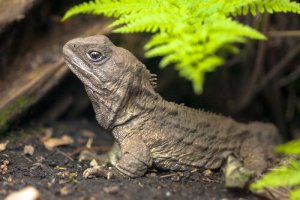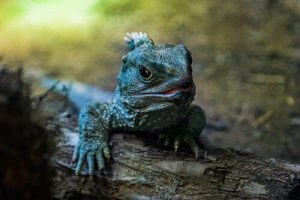The Tuatara: A Survivor from the Dinosaur Era

An endemic species of New Zealand, the tuatara is a reptile belonging to the order Rhynocephalia. While it might look like an ordinary lizard, it is actually more closely related to reptiles that lived back in the Cenozoic era. In fact, its ancestors date back to the Triassic period, over 200 million years ago.
Classification
As we’ve already mentioned, the tuatara is part of the order Rhinocephalia. This ancient family of diapsids reached its peak during the Jurassic period, before being wiped out during the Cretaceous era.
Around 60 million years ago, almost every last species of Rhinocephalia disappeared. Except for one. One species survived, and it still lives today: Sphenodon puntactus, the New Zealand tuatara.
However, it does have two close relations: two subspecies, known as Sphenodon guntheri, and Sphenodon puntactus puntactus. S. guntheri is significantly smaller than S. puntactus, making them easily distinguishable from one another.
The tuatara: characteristics
The most notable characteristic of this “living fossil” is the spiny crest along its back. Although it’s present in both males and females, it’s more prominent in males. These crests are made up of soft folds of coarse skin, which hang loosely around their large heads.
While they can hear, the tuatara doesn’t have external ears. Its limbs are strong, and very well-developed. It measures between 20 and 28″ in length, and weighs between 1 and 2 lbs.
These animals have an extremely long lifespan, and have the slowest growth rates of any reptile. Some females don’t reach sexual maturity until the age of 20, and it can take between 12 and 15 months for eggs to hatch.

Experts estimate that they can live for over 100 years. As a result, reproduction is a rather rare event in the lives of these animals.
Habitat and diet
The tuatara and the two related subspecies can be found in several different locations, scattered across the two main islands that make up New Zealand.
- Sphenodon puntactus: commonly found on New Zealand’s North Island.
- Sphenodon guntheri: First discovered in 1989, S. guntheri lives on the small islands in the Cook Strait.
These land animals prefer rocky terrain, especially near the coast. Unlike most reptiles, the tuatara breathes rather slowly. While at rest, it can go an hour between one breath and the next.
Tuatara are nocturnal carnivores and insectivores. They have a varied diet of insects, snails, eggs, chicks and small lizards. There have even been some recorded cases of cannibalism.
Conservation
Like many others, tuatara are an endangered species. In 1996, they appeared on the IUCN Red List of Threatened Species. Today, however, they are considered to be at low risk of extinction.
It is currently unknown exactly how many tuatara there are in the world. However, experts believe that the population is severely fragmented.

Here are just some of the many measures that have been put into place to ensure the tuatara’s survival:
- The creation of wildlife sanctuaries
- Importation of frogs to boost their food supply
- The removal and control of mammal populations
- The reintroduction of tuatara into national parks
Only a few decades ago, tuatara were on the brink of extinction. Human interference led to habitat loss, and the introduction of invasive species such as rats and weasels had a serious impact on their habitat and food sources.
Interesting facts about the tuatara
The first tuatara lived roughly 240 million years ago, at the same time as the dinosaurs. Although evolutionary convergence has meant that you could mistake them for iguanas, they aren’t actually all that closely related.
As of yet, scientists still haven’t discovered the purpose of the tuatara’s third eye. Also known as the parietal or pineal eye, it is located on the top of its head. Inside, protected by a layer of connective tissue, is the pineal organ. Believed to be light-sensitive, some studies suggest that it can detect infrared, and may help them track down prey.
The function of the pineal gland can vary greatly from species to species. In reptiles, it’s in charge of regulating body temperature, while in mammals, it controls the animal’s circadian rhythms. It is also involved in regulating seasonal behavior, such as hibernation and mating rituals.
Unlike other reptiles, tuatara actually like the cold, and are able to survive in temperatures as low as 41°F during hibernation. However, temperatures higher than 77°F can be fatal.
An endemic species of New Zealand, the tuatara is a reptile belonging to the order Rhynocephalia. While it might look like an ordinary lizard, it is actually more closely related to reptiles that lived back in the Cenozoic era. In fact, its ancestors date back to the Triassic period, over 200 million years ago.
Classification
As we’ve already mentioned, the tuatara is part of the order Rhinocephalia. This ancient family of diapsids reached its peak during the Jurassic period, before being wiped out during the Cretaceous era.
Around 60 million years ago, almost every last species of Rhinocephalia disappeared. Except for one. One species survived, and it still lives today: Sphenodon puntactus, the New Zealand tuatara.
However, it does have two close relations: two subspecies, known as Sphenodon guntheri, and Sphenodon puntactus puntactus. S. guntheri is significantly smaller than S. puntactus, making them easily distinguishable from one another.
The tuatara: characteristics
The most notable characteristic of this “living fossil” is the spiny crest along its back. Although it’s present in both males and females, it’s more prominent in males. These crests are made up of soft folds of coarse skin, which hang loosely around their large heads.
While they can hear, the tuatara doesn’t have external ears. Its limbs are strong, and very well-developed. It measures between 20 and 28″ in length, and weighs between 1 and 2 lbs.
These animals have an extremely long lifespan, and have the slowest growth rates of any reptile. Some females don’t reach sexual maturity until the age of 20, and it can take between 12 and 15 months for eggs to hatch.

Experts estimate that they can live for over 100 years. As a result, reproduction is a rather rare event in the lives of these animals.
Habitat and diet
The tuatara and the two related subspecies can be found in several different locations, scattered across the two main islands that make up New Zealand.
- Sphenodon puntactus: commonly found on New Zealand’s North Island.
- Sphenodon guntheri: First discovered in 1989, S. guntheri lives on the small islands in the Cook Strait.
These land animals prefer rocky terrain, especially near the coast. Unlike most reptiles, the tuatara breathes rather slowly. While at rest, it can go an hour between one breath and the next.
Tuatara are nocturnal carnivores and insectivores. They have a varied diet of insects, snails, eggs, chicks and small lizards. There have even been some recorded cases of cannibalism.
Conservation
Like many others, tuatara are an endangered species. In 1996, they appeared on the IUCN Red List of Threatened Species. Today, however, they are considered to be at low risk of extinction.
It is currently unknown exactly how many tuatara there are in the world. However, experts believe that the population is severely fragmented.

Here are just some of the many measures that have been put into place to ensure the tuatara’s survival:
- The creation of wildlife sanctuaries
- Importation of frogs to boost their food supply
- The removal and control of mammal populations
- The reintroduction of tuatara into national parks
Only a few decades ago, tuatara were on the brink of extinction. Human interference led to habitat loss, and the introduction of invasive species such as rats and weasels had a serious impact on their habitat and food sources.
Interesting facts about the tuatara
The first tuatara lived roughly 240 million years ago, at the same time as the dinosaurs. Although evolutionary convergence has meant that you could mistake them for iguanas, they aren’t actually all that closely related.
As of yet, scientists still haven’t discovered the purpose of the tuatara’s third eye. Also known as the parietal or pineal eye, it is located on the top of its head. Inside, protected by a layer of connective tissue, is the pineal organ. Believed to be light-sensitive, some studies suggest that it can detect infrared, and may help them track down prey.
The function of the pineal gland can vary greatly from species to species. In reptiles, it’s in charge of regulating body temperature, while in mammals, it controls the animal’s circadian rhythms. It is also involved in regulating seasonal behavior, such as hibernation and mating rituals.
Unlike other reptiles, tuatara actually like the cold, and are able to survive in temperatures as low as 41°F during hibernation. However, temperatures higher than 77°F can be fatal.
All cited sources were thoroughly reviewed by our team to ensure their quality, reliability, currency, and validity. The bibliography of this article was considered reliable and of academic or scientific accuracy.
- Australasian Reptile & Amphibian Specialist Group 1996. Sphenodon punctatus. The IUCN Red List of Threatened Species 1996: e.T20613A9214781. http://dx.doi.org/10.2305/IUCN.UK.1996.RLTS.T20613A9214781.en. Downloaded on 21 June 2019. Online: https://www.iucnredlist.org/species/20613/9214781
-
La gran enciclopedia de los animales – Volumi singoli – Google Libros [Internet]. [citado 21 de junio de 2019]. Disponible en: https://books.google.es/books?id=_isMv3IOdWwC&pg=PA104&dq=tu%C3%A1tara&hl=es&sa=X&ved=0ahUKEwiyq_jOmfriAhVUTBUIHUHSBOIQ6AEIRjAF#v=onepage&q=tu%C3%A1tara&f=false
-
Conservation Evidence: Evidence Data [Internet]. [citado 21 de junio de 2019]. Disponible en: https://www.conservationevidence.com/data/index?terms=Tuatara&yt0=
This text is provided for informational purposes only and does not replace consultation with a professional. If in doubt, consult your specialist.








